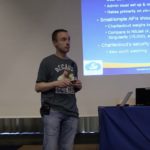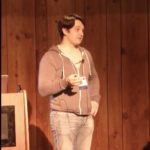Today Sylabs announced a multi-phase collaboration with Google Cloud as a technology partner. Aimed at systematically addressing enterprise requirements in a cloud-native fashion, the first phase of the collaboration will be based upon availability of Sylabs’ SingularityPRO via the Google Cloud Platform Marketplace. “Singularity is a widely adopted container runtime that implements a unique security model to mitigate privilege escalation risks, and provides a platform to capture a complete application environment into a single file.”
SDSC and Sylabs Gather for Singularity User Group
The San Diego Supercomputer Center (SDSC) at UC San Diego, and Sylabs.io recently hosted the first-ever Singularity User Group meeting, attracting users and developers from around the nation and beyond who wanted to learn more about the latest developments in an open source project known as Singularity. Now in use on SDSC’s Comet supercomputer, Singularity has quickly become an essential tool in improving the productivity of researchers by simplifying the development and portability challenges of working with complex scientific software.
Singularity 3.1.0 brings in Full OCI Compliance
Today Sylabs announced that Singularity 3.1.0 is now generally available. With this release, Singularity is fully compliant with standards established by the Open Containers Initiative (OCI), and benefits from enhanced management of cached images. Open source based Singularity continues to systematically incorporate code-level changes specific to the Darwin operating environment, as it progresses towards support for macOS platforms. These, and […]
Singularity: Container Workflows for Compute
Greg Kurtzer from Sylabs gave this talk at the Stanford HPC Conference. “Singularity is a widely adopted container technology specifically designed for compute-based workflows making application and environment reproducibility, portability and security a reality for HPC and AI researchers and resources. Here we will describe a high-level overview of Singularity and demonstrate how to integrate Singularity containers into existing application and resource workflows as well as describe some new trending models that we have been seeing.”
Video: Container Mythbusters
Michael Jennings from LANL gave this talk at the Stanford HPC Conference. “As containers initially grew to prominence within the greater Linux community, particularly in the hyperscale/cloud and web application space, there was very little information out there about using Linux containers for HPC at all. In this session, we’ll confront this problem head-on by clearing up some common misconceptions about containers, bust some myths born out of misunderstanding and marketing hype alike, and learn how to safely (and securely!) navigate the Linux container landscape with an eye toward what the future holds for containers in HPC and how we can all get there together!”
The Inaugural Singularity User Group Meeting: Registration Open Now
The San Diego Supercomputer Center (SDSC) and Sylabs have teamed up to bring the Community its first ever meeting of the Singularity User Group (SUG). Singularity has become what it is today through the engagement of users, developers, and providers that have collectively developed a sense of community around the software and its ecosystem. Read on as Ian Lumb, Technical Writer at Sylabs, shares the origins of the new annual Singularity User Group Meeting.
Argonne Looks to Singularity for HPC Code Portability
Over at Argonne, Nils Heinonen writes that Researchers are using the open source Singularity framework as a kind of Rosetta Stone for running supercomputing code almost anywhere. “Once a containerized workflow is defined, its image can be snapshotted, archived, and preserved for future use. The snapshot itself represents a boon for scientific provenance by detailing the exact conditions under which given data were generated: in theory, by providing the machine, the software stack, and the parameters, one’s work can be completely reproduced.”
Sylabs Tunes Singularity 3.0 Containers for Machine Learning
Today Sylabs announced that it has released a new version of its innovative container software: Singularity 3.0. With new enterprise-class features, Singularity is now the premier container runtime solution, enabling your company to seamlessly and efficiently tackle today’s most demanding AI, machine learning, and advanced analytic workloads. “Lenovo and Sylabs have collaborated for over two years around a shared vision of producing lightweight HPC containers that are flexible, secure, and reproducible, while also delivering performance that is equal to native OS performance.”
Containers: Shifter and Singularity on Blue Waters
In this video from the Blue Waters 2018 Symposium, Maxim Belkin presents a tutorial on Containers: Shifter and Singularity on Blue Waters. “Container solutions are a great way to seamlessly execute code on a variety of platforms. Not only they are used to abstract away from the software stack of the underlying operating system, they also enable reproducible computational research. In this mini-tutorial, I will review the process of working with Shifter and Singularity on Blue Waters.”
Univa Announces Collaboration with Sylabs for HPC Containers
Today Univa announced a partnership with Sylabs to offer enhanced support and integration for Sylabs’ Singularity container platform in Univa Grid Engine and other Univa products. “Customers are rapidly embracing containers for high-performance workloads and Singularity offers clear advantages,” said Gary Tyreman, CEO of Univa. “We’re delighted to be collaborating with Sylabs to make container technology easier to use and deploy. By improving interoperability between Univa products and Singularity, we can make it easier for customers to reap the benefits associated with container technology.”










